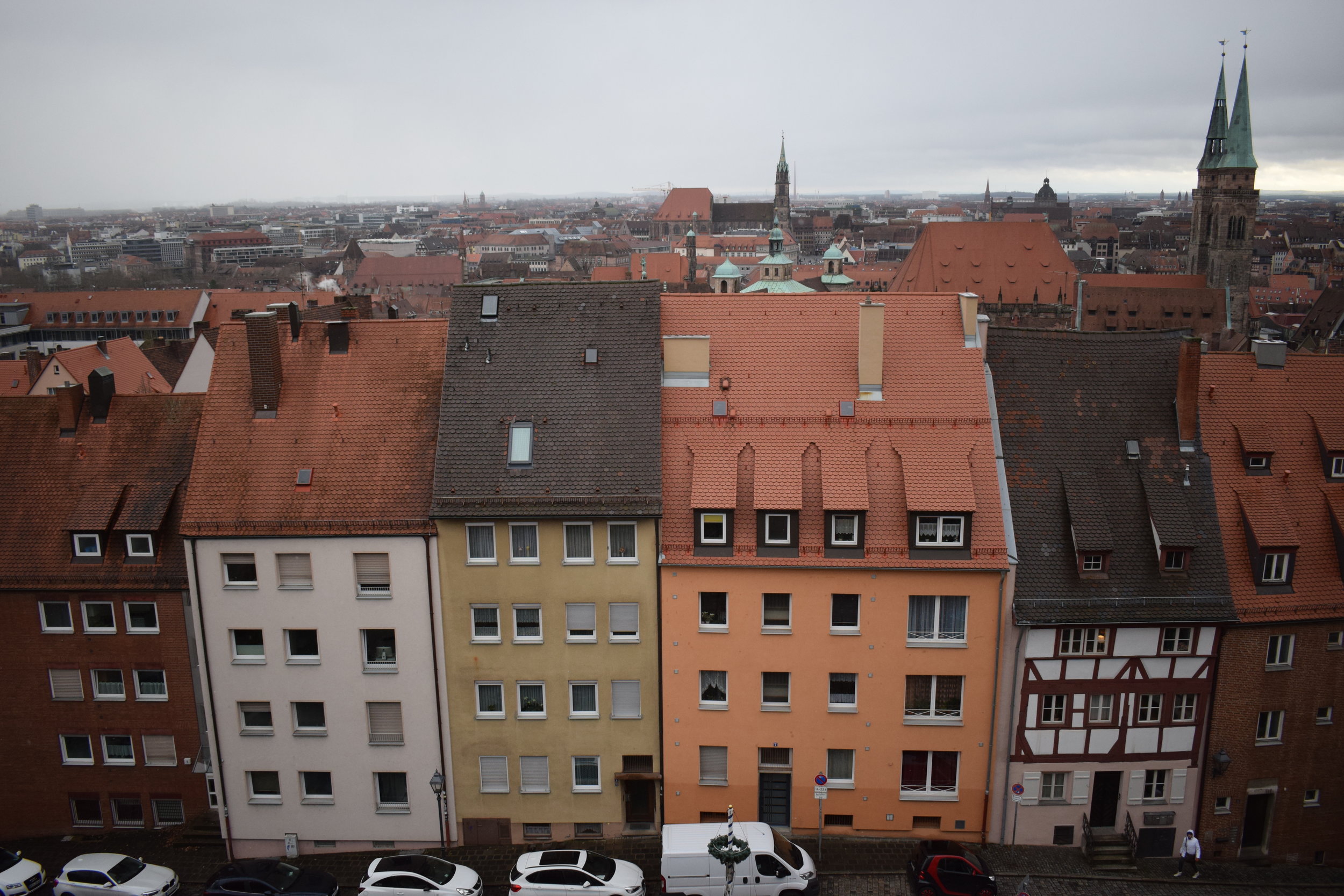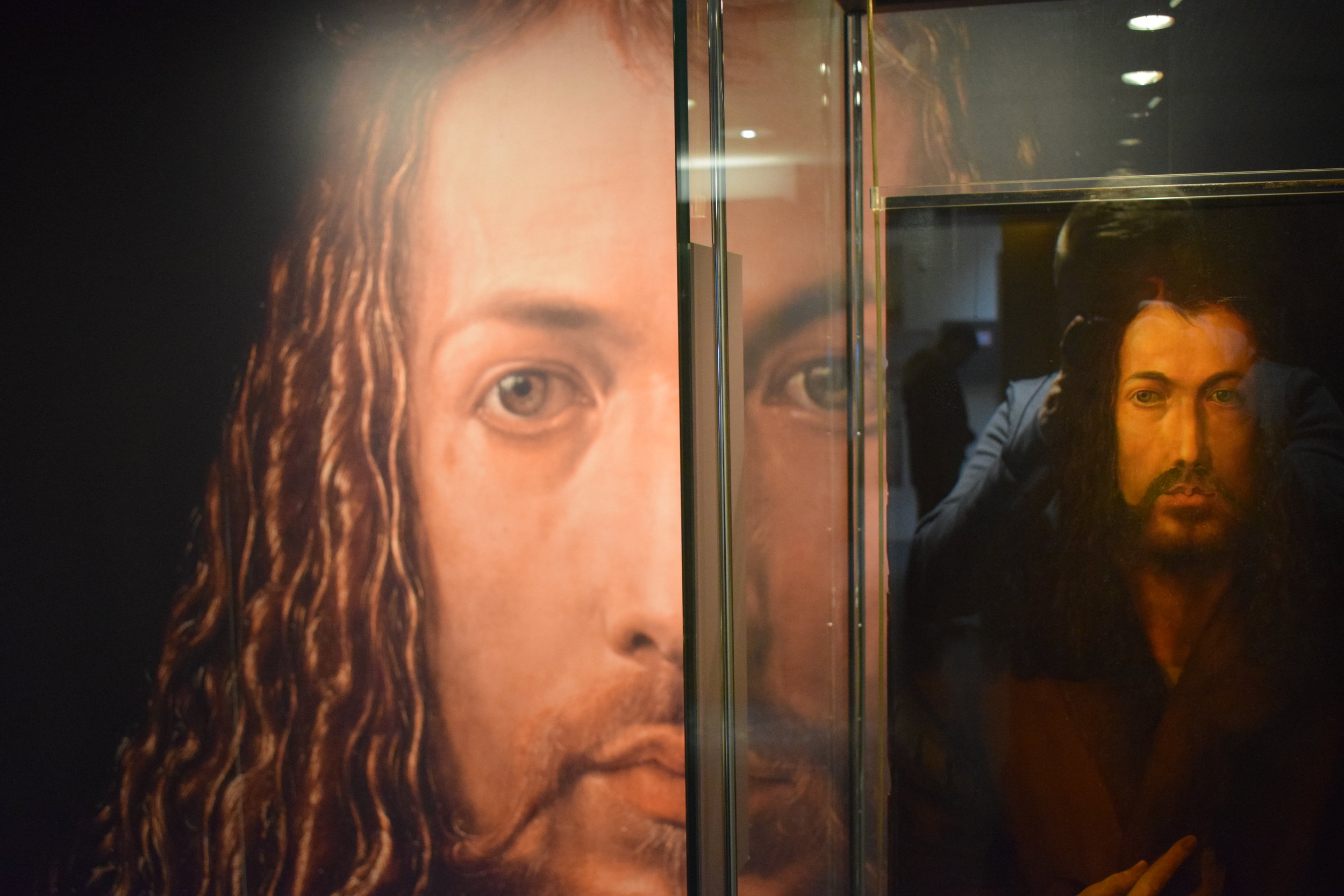Quick Travel Guide: Nuremberg, Germany
/Note: This post contains sponsored content and/or links.
NUREMBERG
Country: Germany
Population: 511,628
Time zone: UTC +1
Closest airport(s): Nuremberg Airport
A little bit about Nuremberg
Looking out over Nuremberg.
Nuremberg is Bavaria’s second city and the largest in Franconia. Situated on the Pegnitz River and the Rhine-Main-Danube Canal, Nuremberg was the undeclared capital of the Holy Roman Empire and for centuries has hosted kings and emperors, gaining its reputation as an imperial city.
Nuremberg was a key player in Germany’s industrial revolution, and its working-class demographic provided the perfect stage for the Nazi party to hold fanatical rallies and begin the boycott of Jewish businesses.
90% of residential buildings were reduced to rubble during the Second World War, but perhaps the city’s biggest WWII contribution came in the shape of the Nuremberg Trials – the series of military tribunals which brought to account the war crimes of several prominent German officials.
In the following years, Nuremberg restored some of its former glory by building the city back up using the original, remaining stone, and now enjoys its place as a thriving historical and cultural centre.
Why should I go?
Standing outside the former house of Albrecht Dürer.
There are a variety of reasons to go to Nuremberg. Cheap flights, energetic nightlife and eye-catching architecture, to name a few. Nuremberg is one of those cities that was built with a weekend break in mind, with its medieval walled old town the focus of its activity.
Whether you want a weekend away with your mates, a quick, romantic getaway or fancy doing something different with the kids – Nuremberg will leave you in the comfort of knowing your time has been well spent.
The main attractions
Nuremberg Castle
Overlooking the city from its perch on top of a protruding hill, Nuremberg Castle is a collection of buildings which come together to form a medieval fort which is open to visitors throughout the year. Although the ascent up the sandstone ridge to the castle isn’t for the faint-hearted, it is certainly worth the effort with the main exhibition, where visitors can take a look inside, giving a great insight into its history.
Nuremberg Castle was one of the most important palaces of the Holy Roman Empire and from 1356 it was decided that every newly-elected future ruler must hold his first imperial diet in the city. At the castle you’ll get the chance to see Sinwell Tower, as well as the 47 metre-deep Deep Well, which has been hewn into the rock.
Documentation Center Nazi Party Rally Grounds
The Documentation Center Nazi Party Rally Grounds is a museum inside the north wing of the unfinished remains of the Congress Hall of the former Nazi party rallies, which was designed to hold 50,000 people.
Embracing the building rather than tearing down walls and starting afresh, this steel and glass brick installation provides a fascinating look at the history of the far-right organisation’s party rallies, mass events and the causes, context and consequences of the National Socialist regime of terror.
Memorium Nuremberg Trials
This museum documents the entirety of the Nuremberg Trials – where the leaders of the Nazi regime were held to account for their crimes following World War II. Starting with a brief history of both World Wars, the exhibition goes into detail about how the trials were carried out from the physical setup to the defendants’ defence, while also including lesser-considered aspects such as media involvement and the Nuremberg Trials’ legacy and influence on global law today.
One of the outstanding features of the Memorium Nuremberg Trials is Courtroom 600. Although still used today for its intended purpose, when it is vacant, visitors are able to go inside and take a look inside the place where, over seven decades ago, these infamous tribunals took place.
Albrecht Dürer’s House
Albrecht Dürer, one of Germany’s most famous and revered artists and a Nuremberg native, lived and worked in a large, half-timbered house not too far from Nuremberg Castle. Today the house remains as a shrine to Dürer, providing a life-size timeline of his life, while also displaying some of his most prominent art work.
City Museum at Fembo House
If you want to learn all about Nuremberg and its history, then make sure you stop by the City Museum at Fembo House.
Nuremberg’s only surviving large Late Renaissance merchant’s house is halfway up the hill to the castle and has some architectural gems including the beautifully ornate central room of the house, with its wonderful Baroque stucco ceiling.
Getting there
Nuremberg Hauptbahnhof at night.
The two main ways to get to Nuremberg are by air or rail. Nuremberg Airport is served by several budget and regional airlines, making it an accessible place throughout the continent. Ryanair operate direct services from Manchester and London Stanstead, usually for ridiculously low prices.
Nuremberg Hauptbahnhof is the gateway for rail travellers, with regular, direct departures and arrivals to and from major cities all over Germany, as well as Austria and Czech Republic.
Getting from the airport to the city centre is made easy, with the U2 U-Bahn providing a direct connection, while the central train station is just steps from Nuremberg’s old, historical centre.
Getting around
Most of Nuremberg is navigable by foot, but for those looking to venture out of the old centre and head to sites such as the Documentation Center Nazi Party Rally Grounds and Memorium Nuremberg Trials, it is best to utilise Nuremberg’s fantastic public transportation systems.
The U-Bahn is Nuremberg’s underground train network, supplemented by the overground S-Bahn, buses and trams. Travel on all public transport services is covered by the NURNBERG CARD, saving time on getting individual tickets at each station as well as money.
Where to stay
I stayed at the DJH Youth Hostel Nuremberg, one of the most remarkable accommodations I’ve ever had the pleasure of being a guest at. Set inside the refurbished old stables of Nuremberg Castle, this hostel has both private rooms and dormitories and has a fantastic bistro which caters for guests throughout the day. Staying here was a real experience and I would recommend it to anyone.
Nuremberg has plenty of other options though, whether it’s four or five-star luxury you’re looking for or somewhere cheap and cheerful. Booking.com has a great range of Nuremberg hotels, hostels and apartments to choose from.
Eat and drink
The famous Nurnbergers with potato salad and bread at Bratwursthäusle.
Nuremberg is famed for two main parts of its culinary experience – sausages and red beer. To most, that would sound tasty, but to Nuremberg they are part of its identity. Mini bangers called Nurnberger bratwursts are served up with bread, potato salad and sauerkraut, and are best eaten at Bratwursthäusle. Bratwursthäusle, which dates back to 1313 and is Nuremberg’s oldest restaurant, is credited with the invention of the grilled Nuremberg Bratwurst, which gained Protected Geographical Indication from the European Union in 2003 as Europe’s first sausage. This restaurant was my favourite because it was simple, traditional, atmospheric and not to be missed.
A half-litre of red beer from Hausbrauerei Altstadhof.
The city has also been brewing red beer since the Middle Ages. There’s some disagreement over whether the beer originated in Nuremberg or Belgium, but regardless, the German town serves up a fantastic pint at Hausbrauerei Altstadhof. Although this pub is known for its beer, they also have a food menu as well as offering a tour of their craft brewery and underground rock-cut cellars, which were once used for the ripening and storage of the city’s beer.
Freshly-made potato chips and a bottle of Fanta - which actually originated in Germany - at Café & Bar Celona.
Cafés and café bars are also a popular shout in this part of the world, and they are dotted throughout the city. I stopped off for a spot of lunch at Café Bar Celona and enjoyed a long sandwich and freshly-made potato chips with a nice view of the nearby river, but that was just one of an incredible array. For dessert I stopped off at one of the local, independent cafés, which you can find out more about below.
One interesting restaurant for you to try is Auguste Premium Junkfood. This burger bar serves up tasty patties made of organic, regional and sustainable products and its décor is wholly upcycled. Albrecht-Dürer-Stuben is a great selection for those wanting to try some of the local cuisine, with famous Franconian fare including the delicious Schäufele, which is pork shoulder accompanied by dumplings.
The Mati Hara Bar is one of Nuremberg's smallest, but most lively.
Nuremberg also has a lively drinking scene, with nightlife hotspots aplenty. The Mata Hari Bar is the city’s most well-known watering hole, famous for its Franconian beers and ice cream shots. It’s a small place with a big personality, meaning it’s usually standing room only while partying into the early hours. Two of the biggest Nuremberg nightclubs are Club Stereo and Mach1 Club, both of which offer loud music, well-priced drinks and energetic dancefloors.
Club Stereo is one of Nuremberg's premiere nightclubs.
And sports fans will love Sportsbar Nuremberg. Housed inside the central train station, this bar has plenty of big screens and seating for the big game. The mix of sports fans and awaiting train passengers creates a nice atmosphere and encourages interesting conversation.
Five observations
Everything is easier with NURNBERG CARD
The NÜRNBERG CARD was a great companion during my trip. Every museum and attraction I went into was included in the €28 price tag, giving me an immediate saving, as was all public transport in the Nuremberg and Fürth area. Aside from its financial benefit, it was also a big time saver. I didn’t have to wait in line to purchase a U-Bahn ticket, nor did I have to scramble for notes and coins in my wallet when going up to a ticket desk. I simply presented my NÜRNBERG CARD and went about my business. Nice and easy!
The city’s favourite son
Albrecht Dürer: remember the name. It’s virtually impossible to go to Nuremberg and not hear of the city’s favourite son. He’s got a street named after him, an airport and even a square, in the middle of which is a statue of the famous artist. Despite living almost five centuries ago, Dürer’s legacy is alive and well in Nuremberg.
Nuremberg Airport
A café culture
One of the things that really impressed me about Nuremberg was its café culture. Independent coffee shops and snack bars line side streets as well as the banks of the Pegnitz river, with some open all day for breakfast, dinner and lunch.
I tried some out, and one of my favourites was Café Il Amore, a cosy, popular and unassuming place offering homemade, fresh cakes and refreshments. Café Bar Katz is also a hit with both locals and visitors and I should know, as I rocked up and was unable to get a seat it was that busy in there! This hip, vintage café has a wide variety of homemade baked goods, sandwiches, salads, soups and coffee, meaning you’ll go neither hungry nor thirsty.
Day of rest
When I went out on Sunday to do some pre-flight exploration, I was greeted by masses of space in Nuremberg city centre. Just the day before the streets were packed with locals and tourists alike, but on Sunday the city felt like it had gone into lockdown. Most shops were shut, and few people braved the grey skies and cool air. But that’s not a bad thing, as all the museums and attractions remained open, and less people meant less interference while taking photos!
The Nuremberg Weekender
One of the best things about Nuremberg is that I was able to do it in a weekend, without taking a day off work or gut-punching my wallet. I wrote more about that here, so make sure to check it out!
Did you know?
Nuremberg is home to Spielwarenmesse – the world’s largest international trade fair for toys and games! It has been held annually since 1949 and only trade visitors associated with the toy business, journalists and invited guests are admitted.



























































If you’re travelling to Belfast, here’s everything you need to know including what to see, where to eat, where to stay and how to get there.